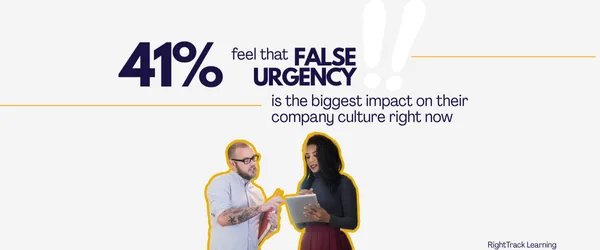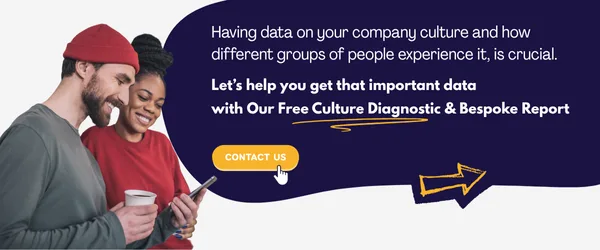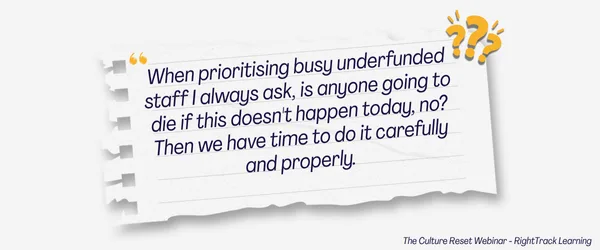Organisational culture isn’t a poster. It isn’t an agenda point in a meeting. It lives in the spaces between words and in the actions of people when no one’s watching. It is the feeling people have before coming to work, and what they take with them when going home.
Last week we held The Culture Reset webinar where the participants referred to company culture as ‘The way we do things around here’, ‘how it feels, how people operate – the ‘norms’’, ‘how people, think, feel and act’.
Every organisation has a culture, whether intentional or not. Even if company culture can’t be touched, just ask your people, they will be able to name it. In good and in bad. Left alone, culture doesn’t stay neutral, it drifts. And that drift can pull a team away from trust, innovation and connection.
Right now, that drift is prevalent and increasing in our organisations. You can see it in presenteeism, in “quiet quitting” and in the growing perception gap between leadership and employees. Has your organisation had a bunch of great people leave? Yep, another sign there’s something amiss. Yet often culture is treated like wallpaper: something you notice only when it’s peeling. But it’s the foundations of everything else. Get it wrong, you’ll be fighting a headwind. Get it right, you have a breeze in your sails.
Read on… or download The Culture Reset webinar recording now. Here’s a teaser:
Slogans won’t fix what’s wrong with organisational culture
So, where do you feel you are with the culture in your organisation? And would others agree? Is your culture helping or holding you back? Whichever it is, the work on culture needs to be intentional, and it won’t be wasted. This applies whether you’re trying to turn the ship around or build on something that is already going well.
A “culture reset” is a conscious stop/start moment: pause, notice what’s really happening and make small, deliberate shifts. Without that, the drift becomes norms that are hard to reverse.
During our webinar, we discussed that the biggest danger is not toxic culture, it’s passive culture – where everyone knows things are off, but no one owns it. In that vacuum, the loudest voices, budget squeezes and AI-driven changes will set the tone for you.
Five mistakes organisations make:
From what we see with our work in various sectors, there are five recurring red flags which signal culture collapse:
- Performance theatre. Staying late to be seen or polishing decks creates the appearance of progress. Real learning, experimentation and innovation grind to a halt.
- The loyalty tax. Long-serving employees go quiet because questioning decisions gets labelled “negative”. Valuable insight and challenge are lost.
- False urgency. Everything becomes “top priority”. Leaders chase quick wins. People feel reactive, never strategic. Burnout rises.
- Trust debt. Promising to “pick this up next time” but failing to follow through erodes psychological safety. Employees stop sharing ideas because they see nothing changing.
- Toxic positivity. Team engagement ends with “everything’s great” messages. Underneath sarcasm, frustration and unspoken conflict steadily build.
Sound familiar? You’re not alone. In our live poll during the webinar, false urgency was the clear front-runner as the red flag (41%) people saw most in their organisations.

Why this matters more than you think
In our webinar, we explored the business case for a culture reset. While numbers alone don’t tell the full story, they absolutely shine a light on why culture drift can’t be ignored. In fact, it was the data that first sparked the idea for the session – because so many organisations are grappling with the same challenges.
Here are some figures that highlight just how costly culture drift can be:
- Global employee engagement has dropped from 23% to 21% – only the second decline in 12 years (Gallup, State of the Global Workplace, 2025).
- Only 39% of employees now believe someone at work genuinely cares about them, down from 47% in 2020 (Gallup, State of the Global Workplace, 2025).
- Presenteeism accounted for more than 83% of the increase in the costs of lost productivity to the UK economy, which is 5 times more than absenteeism (The Institute for Public Policy Research, 2024).
These figures show up in your recruitment budget, innovation pipeline and customer experience. The question isn’t “can we afford a reset?” but “what will it cost if we don’t?”
Having the numbers matters
Having data on your company culture and how different groups of people experience it – between different departments, levels of seniority, tenure, geographical locations, age, ethnicity, gender and so on – is crucial. They provide evidence for what people might already be sensing at work, and without that evidence, it’s all too easy for culture, and its impact on performance, engagement, and retention, to be dismissed.
As part of the Culture Reset initiative, we are offering our Culture Diagnostic survey, bespoke report and 1-hour consultancy free of charge to a limited number of organisations (with >200 people – where we can gather viable data sets). Please reach out if you’d like to register your interest.

Three levers for any leader
If you want to begin, focus on three things you can directly influence:
- Signals. Recognise people for how they work, not just what they deliver. Publicly highlight collaboration, progress, healthy boundaries and creativity.
- Structures. Break the autopilot of same-old meetings. Rotate who sets the agenda, use silent brainstorming to surface different voices, adjust policies that contradict values.
- Stories. Share lived examples of challenging norms and finding better paths. Make sure the stories you tell internally actually match daily reality.
When these three are consistent, culture feels positive. When they’re neglected, drift accelerates.
The 1° shift mindset
Culture change can feel like turning a cargo ship. It’s slow, especially if the tide is against you. But you don’t have to rotate 180° overnight. Start with a single degree.
Let’s talk about the 1° shift mindset. Culture won’t change overnight, but small steps add up. In the webinar, participants agreed that intentional, practical actions can drive real change. When we asked what one step they could take immediately, the responses were simple, encouraging and actionable:
- Make more time for personal conversations with people I don’t work closely with.
- Introduce the concept of signals, structures and stories into our leadership meetings.
- Think how I can make someone feel cared about and important.
- Taking responsibility for creating what I find lacking in the workplace.
- Have a try at ‘changing things up’ in routine meetings.
- Reduce the trust debt, actively follow up with people.

Stop chasing quick wins, start building momentum
One of the best comments from the session came from a participant managing an underfunded team: “I always ask, is anyone going to die if this doesn’t happen today? No? Then we have time to do it carefully and properly.” That is a reset mindset. Slow down enough to do the important things well.
Leaders often overestimate what can be done with a new programme and underestimate what can be done with consistent micro-actions, like recognition, clarity, and empathy. Those aren’t soft extras, they are oxygen. Without it, people, results and performance wither.
Questions to start your own reset
- Which red flag of culture drift do we see most?
- What’s one signal, structure or story that shapes our culture right now – for better or worse?
- What 1° shift could we try this week?
Ask yourself. Ask your team. Then take action.
If this resonates, download our webinar recording to get more details on what was discussed and what three things you can focus on to chart shifting the culture. Also check out our Culture Reset Programme – it can give you structured support to turn these ideas into action, helping your organisation build trust, clarity and connection.